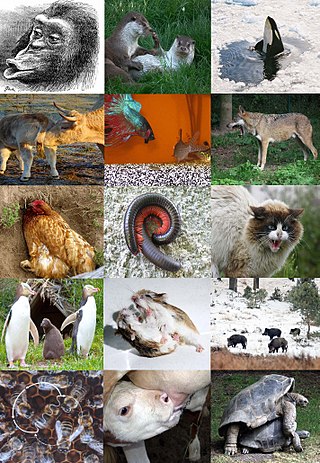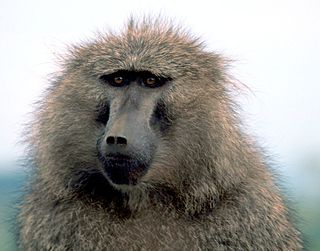History
The 'hundredth monkey' effect was popularized in the mid-to-late 1970s by Lyall Watson, who documented the findings of several Japanese primatologists from the 1950s. [1]
Watson (1970s)
Between 1952 and 1953, [lower-roman 1] primatologists conducted a behavioral study of a troop of Macaca fuscata (Japanese monkeys) on the island of Kōjima. The researchers would supply these troops with such foods as sweet potatoes and wheat in open areas, often on beaches. [1] An unanticipated byproduct of the study was that the scientists witnessed several innovative evolutionary behavioral changes by the troop, two of which were orchestrated by one young female, and the others by her sibling or contemporaries. The account of only one of these behavioral changes spread into a phenomenon (i.e., the 'hundredth monkey effect'), which Watson would then loosely publish as a story. [1]
According to Watson, the scientists observed that some of the monkeys learned to wash sweet potatoes, initially through an 18-month-old female member (named "Imo" by the researchers) of the troop in 1953. Imo discovered that sand and grit could be removed from the potatoes by washing them in a stream or in the ocean. Gradually, this new potato-washing habit spread through the troop—in the usual fashion, through observation and repetition. (Unlike most food customs, this behavior was learned by the older generation of monkeys from younger ones.) [1]
This behavior spread up until 1958, according to Watson, when a sort of group consciousness had suddenly developed among the monkeys, as a result of one last monkey learning potato washing by conventional means (rather than the one-monkey-at-a-time method prior). Watson concluded that the researchers observed that, once a critical number of monkeys was reached—i.e., the hundredth monkey—this previously learned behavior instantly spread across the water to monkeys on nearby islands. [1] [6]
Watson first published the story in a foreword to Lawrence Blair's Rhythms of Vision (1975); [6] the story then spread with the appearance of Watson's 1979 book Lifetide: The Biology of the Unconscious .
Original research (1950s)
The original Koshima research was undertaken by a team of scientists as a secondary consequence of 1948 research on semi-wild monkeys in Japan. The Koshima troop was identified as segregated from other monkeys and, from 1950, used as a closed study group to observe wild Japanese macaque behavior. While studying the group, the team would drop sweet potatoes and wheat on the beach and observe the troop's behavior. In 1954, a paper was published indicating the first observances of one monkey, Imo, washing her sweet potatoes in the water. [7]
Her changed behavior led to several feeding behavior changes over the course of the next few years, all of which was of great benefit in understanding the process of teaching and learning in animal behavior. A brief account of the behavioral changes can be seen below:
- The young first teach their contemporaries and immediate family, who all benefit from the new behavior and teach it to their contemporaries.
- If the parents or their contemporaries (or their parents) are too old, they do not adopt the behavior.
- Once the initial group have children, a change occurs in the dynamic of the behavior from teaching previous and current generations, to a new dynamic where the next generation learns by observation. The behavior is no longer actively taught but passively observed and mimicked.
- The first innovator continues to innovate. The young monkey who started potato washing also learned how to sift wheat grains out of the sand by throwing handfuls of sand and wheat into the water, then catching the wheat that floated to the top. This invention was also copied using the above teaching and learning process until there were too many monkeys on the island with too little wheat apportioned, which is when competition became too fierce and the stronger monkeys would steal the collected wheat from the weaker ones, so they stopped the learned behavior in self-preservation.
- The innovator's sibling started another innovation whereas the monkeys were initially fearful of the ocean, only deigning to put their hands and feet into it, the wheat straining innovation led to monkeys submerging more of their bodies in the water, or play-splashing in the ocean. This behavior was again copied using the above teaching and learning processes.
The study does not indicate a catalyst ratio at which all the Koshima monkeys started washing sweet potatoes, or a correlation to other monkey studies where similar behavior started. To the contrary, it indicated that certain age groups in Koshima would not learn the behavior.
Keyes (1984)
This story was further popularized by Ken Keyes Jr. with the publication of his book The Hundredth Monkey (1984). Keyes's book was about the devastating effects of nuclear war on the planet. Keyes presented the 'hundredth monkey effect' story as an inspirational parable, applying it to human society and the effecting of positive change. [8] Unfortunately, Keyes combined two items of truth: that the Koshima monkeys learned to wash sweet potatoes, and that the phenomenon was observed on neighboring islands. He did not provide substantiating evidence for his claims, diluting the importance of both studies and potentially discrediting the scientists involved. Combining this science with his political views may also have damaged the research credibility, leading to many reporters attempting to 'debunk' the Japanese team's research without doing sufficient research themselves.













